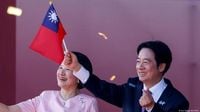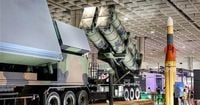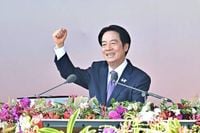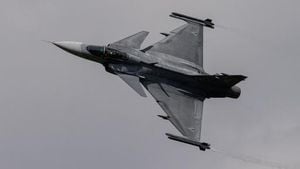On Taiwan’s National Day, October 10, 2025, President Lai Ching-te took to the stage outside the early 20th-century presidential office building in Taipei and delivered a speech that resonated across the region. The message was clear: Taiwan would accelerate the construction of a new, multi-layered air defense system, dubbed “T-Dome,” as part of a sweeping effort to bolster the island’s defenses against mounting military threats from China.
The announcement comes at a time of heightened tension in the Taiwan Strait. China, which claims Taiwan as its own territory, has ramped up both political and military pressure on the democratically governed island. According to Reuters, President Lai’s pledge is not just a matter of rhetoric—it will be backed by a significant increase in defense spending, with plans to raise the budget to over 3% of GDP in 2026 and further to 5% by 2030. A special defense budget proposal is expected by the end of the year, signaling the government’s determination to transform its defense posture.
“The increase in defense spending has a purpose; it is a clear necessity to counter enemy threats and a driving force for developing our defense industries,” Lai stated to an applauding crowd, as reported by Reuters. He continued, “We will accelerate our building of the T-Dome, establish a rigorous air defense system in Taiwan with multi-layered defense, high-level detection, and effective interception, and weave a safety net for Taiwan to protect the lives and property of citizens.”
While details about the T-Dome are still emerging, military experts cited by CNA say the project takes inspiration from Israel’s Iron Dome and the United States’ “Golden Dome” missile defense initiatives. The vision is ambitious: an integrated, multi-layered defense network capable of detecting and intercepting missiles, fighter jets, and drones at all altitudes, providing a shield against the increasingly sophisticated threats posed by China’s expanding arsenal.
Su Tzu-yun, division director at the Institute for National Defense and Security Research, explained, “The name ‘T-Dome’ is inspired by Israel’s Iron Dome and a similar system being introduced in the United States called the ‘Golden Dome.’ Both systems integrate multi-layer air-defense capabilities, and Taiwan’s system would similarly allow the country to shield itself from missiles, fighter jets, and drones across all altitudes.”
Chou Yu-ping, a retired Air Force colonel, added that Taiwan already operates an integrated network as its air defense command-and-control platform, consolidating radar data from ground stations and existing Patriot and Tien Kung missile batteries. The T-Dome, he suggested, could likely adopt a “sensor-to-shooter” system, rapidly linking detection to engagement much like the U.S. Integrated Battle Command System (IBCS), which is designed to neutralize a range of missile threats in their terminal phase.
The urgency behind Lai’s announcement is underscored by China’s recent military displays. On September 3, 2025, Beijing showcased hypersonic and ballistic missiles capable of reaching the U.S. mainland during a major parade, as noted by CNA. The message from the Chinese government is unambiguous: the military threat to Taiwan is very real, and the stakes are high.
China’s response to Taiwan’s defense plans was swift and pointed. Chinese Foreign Ministry spokesperson Guo Jiakun criticized U.S. arms sales to Taiwan and military ties between Washington and Taipei, warning, “The Lai Ching-te authorities’ attempt to seek independence through military means and resist reunification with force will only drag Taiwan into a perilous situation of military conflict.” Beijing continues to insist that “reunification” is the only path to peace and stability, and has rebuffed President Lai’s repeated offers of dialogue.
President Lai, for his part, called on Beijing to “renounce the use of force or coercion to change the status quo across the Taiwan Strait” and emphasized Taiwan’s commitment to “maintain peace through strength.” He drew a sharp distinction between Taiwan’s vibrant democracy and China’s one-party state, describing Taiwan as a “beacon of democracy” in Asia. “Democratic Taiwan ... will strive to maintain the status quo, protect peace and stability in the Taiwan Strait, and promote regional prosperity and development,” Lai declared, according to the Associated Press.
The United States, while not recognizing Taiwan as a sovereign country, has long supplied Taipei with military equipment and supports its right to self-defense. The U.S. has also pressured Taiwan to ramp up its military spending, with former President Donald Trump at one point urging an increase to 10% of GDP—a call reiterated by a Pentagon nominee earlier this year. The T-Dome initiative, as Wen-Ti Sung of the Atlantic Council observed, is a direct response to these expectations: “Lai clearly heard U.S. calls for Taiwan to increase its defense spending, which is why Lai spelled out very specific defense-budget-as-share-of-GDP targets and a specific timeline.”
Taiwan’s defense ministry is also adapting to new threats, including the proliferation of military drones. According to the Associated Press, the ministry is training soldiers to shoot down drones and procuring anti-drone weapons systems as part of its broader modernization efforts. Last month, Taiwan unveiled its latest air defense missile, the Chiang-Kong, designed to intercept mid-level ballistic missiles and reach altitudes higher than the U.S.-made Patriots.
Kuo Yu-jen, director of National Sun Yat-sen University’s Institute of China and Asia-Pacific Studies, noted that Taiwan is following the example of the United States, South Korea, and Japan, all of which have developed integrated, multi-layered air defense systems to counter evolving threats. “Just like the United States, South Korea and Japan, Taiwan is seeking an integrated system that can detect and intercept incoming missiles and enemy aircraft, providing a multi-layered defense to protect the nation against increasingly sophisticated threats,” Kuo said.
The broader context of Lai’s announcement is rooted in Taiwan’s unique history. The island’s National Day commemorates the 1911 uprising that ended China’s last imperial dynasty and established the Republic of China. After losing the civil war to Mao Zedong’s communists in 1949, the Republican government fled to Taiwan, where it continues to operate under the formal name Republic of China. Despite operating independently for over seven decades, Taiwan has avoided a formal declaration of independence, wary of provoking a Chinese military response.
President Lai’s National Day speech also addressed economic challenges, including the impact of high U.S. tariffs imposed by former President Trump. The government has launched a NT$93 billion ($3 billion) plan to support companies, workers, and agricultural sectors affected by the tariffs, and is actively pursuing reciprocal tariff negotiations with the U.S. to secure better trade terms.
As the sun set on Taipei’s National Day celebrations, the mood was one of determination and resolve. Lai’s pledge to build the T-Dome and increase defense spending sends a message not just to Beijing, but to the world: Taiwan is committed to defending its democracy, its people, and its way of life, even as the challenges mount.






